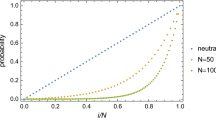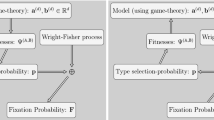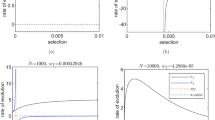Abstract
We study fixation in large, but finite, populations with two types, and dynamics governed by birth-death processes. By considering a restricted class of such processes, which includes many of the evolutionary processes usually discussed in the literature, we derive a continuous approximation for the probability of fixation that is valid beyond the weak-selection (WS) limit. Indeed, in the derivation three regimes naturally appear: selection-driven, balanced, and quasi-neutral—the latter two require WS, while the former can appear with or without WS. From the continuous approximations, we then obtain asymptotic approximations for evolutionary dynamics with at most one equilibrium, in the selection-driven regime, that does not preclude a weak-selection regime. As an application, we study the fixation pattern when the infinite population limit has an interior evolutionary stable strategy (ESS): (1) we show that the fixation pattern for the Hawk and Dove game satisfies what we term the one-half law: if the ESS is outside a small interval around \({1}/{2}\), the fixation is of dominance type; (2) we also show that, outside of the weak-selection regime, the long-term dynamics of large populations can have very little resemblance to the infinite population case; in addition, we also present results for the case of two equilibria, and show that even when there is weak-selection the long-term dynamics can be dramatically different from the one predicted by the replicator dynamics. Finally, we present continuous restatements valid for large populations of two classical concepts naturally defined in the discrete case: (1) the definition of an \({\textsc {ESS}}_N\) strategy; (2) the definition of a risk-dominant strategy. We then present three applications of these restatements: (1) we obtain an asymptotic definition valid in the quasi-neutral regime that recovers both the one-third law under linear fitness and the generalised one-third law for \(d\)-player games; (2) we extend the ideas behind the (generalised) one-third law outside the quasi-neutral regime and, as a generalisation, we introduce the concept of critical-frequency; (3) we recover the classification of risk-dominant strategies for \(d\)-player games.










Similar content being viewed by others
References
Altrock PM, Traulsen A (2009a) Deterministic evolutionary game dynamics in finite populations. Phys Rev E 80:011909. doi:10.1103/PhysRevE.80.011909
Altrock PM, Traulsen A (2009b) Fixation times in evolutionary games under weak selection. New J Phys 11(1):013012
Antal T, Scheuring I (2006) Fixation of strategies for an evolutionary game in finite populations. Bull Math Biol 68(8):1923–1944. doi:10.1007/s11538-006-9061-4
Assaf M, Mobilia M (2010) Large fluctuations and fixation in evolutionary games. J Stat Mech Theory E 2010(09):P09009
Atkinson KE (1989) An introduction to numerical analysis, 2nd edn. Wiley, New York
Bender CM, Orszag S (1999) Advanced mathematical methods for scientists and engineers: asymptotic methods and perturbation theory. Springer, New York
Bruce JW, Giblin PJ (1992) Curves and singularities, 2nd edn. Cambridge University Press, Cambridge
Chalub FACC, Souza MO (2009) From discrete to continuous evolution models: a unifying approach to drift-diffusion and replicator dynamics. Theor Popul Biol 76(4):268–277
Chalub FACC, Souza MO (2014) The frequency-dependent Wright-Fisher model: diffusive and non-diffusive approximations. J Math Biol 68(5):1089–1133
Champagnat N, Ferrière R, Méléard S (2006) Unifying evolutionary dynamics: from individual stochastic processes to macroscopic models. Theor Popul Biol 69(3):297–321. doi:10.1016/j.tpb.2005.10.004
Champagnat N, Ferrière R, Méléard S (2008) From individual stochastic processes to macroscopic models in adaptive evolution. Stoch Models 24(suppl. 1):2–44. doi:10.1080/15326340802437710
Ethier SN, Kurtz TG (1986) Markov processes. Wiley, New York
Ewens WJ (2004) Mathematical population genetics. I: theoretical introduction, 2nd edn. In: Interdisciplinary mathematics, vol 27. Springer, New York
Feller W (1951) Diffusion processes in genetics. In: Proceedings of the second Berkeley symposium on mathematical statistics and probability, 1950. University of California Press, Berkeley and Los Angeles, pp 227–246
Fisher RA (1930) The genetical theory of natural selection. Clarendon Press, Oxford
Fournier N, Méléard S (2004) A microscopic probabilistic description of a locally regulated population and macroscopic approximations. Ann Appl Probab 14(4):1880–1919. doi:10.1214/105051604000000882
Gillespie J (1981) The transient properties of balancing selection in large finite populations. J Math Biol 11(2):169–180. doi:10.1007/BF00275440
Gillespie JH (1989) When not to use diffusion processes in population genetics. In: Feldman MW (ed) Mathematical evolutionary theory. Princeton University Press, New Jersey, pp 57–70
Gokhale CS, Traulsen A (2010) Evolutionary games in the multiverse. P Natl Acad Sci USA 107(12):5500–5504
Gokhale CS, Traulsen A (2014) Evolutionary multiplayer games. Dyn Games App 4(4):468–488
Harsanyi JC, Selten R (1988) A general theory of equilibrium selection in games. MIT Press, Cambridge
Hinch EJ (1991) Perturbation methods. Cambridge University Press, UK
Hofbauer J, Sigmund K (1998) Evolutionary games and population dynamics. Cambridge University Press, Cambridge
Kandori M, Mailath GJ, Rob R (1993) Learning, mutation, and long run equilibria in games. Econometrica 61(1):29–56
Karlin S, Taylor HM (1975) A first course in stochastic processes, 2nd edn. Academic Press [A subsidiary of Harcourt Brace Jovanovich, Publishers], New York-London
Kimura M (1962) On the probability of fixation of mutant genes in a population. Genetics 47:713–719
Kurokawa S, Ihara Y (2009) Emergence of cooperation in public goods games. P Roy Soc B Biol Sci 276(1660):1379–1384
Lessard S (2005) Long-term stability from fixation probabilities in finite populations: new perspectives for ESS theory. Theoret Popul Biol 68(1):19–27. doi:10.1016/j.tpb.2005.04.001
Lessard S (2011) On the robustness of the extension of the one-third law of evolution to the multi-player game. Dyn Games App 1(3):408–418
Lessard S, Ladret V (2007) The probability of fixation of a single mutant in an exchangeable selection model. J Math Biol 54:721–744. doi:10.1007/s00285-007-0069-7
Ludwig D (1975) Persistence of dynamical systems under random perturbations. SIAM Rev 17(4):605–640
Maynard Smith J (1982) Evolution and the theory of games. Cambridge University Press, Cambridge
McKane AJ, Waxman D (2007) Singular solutions of the diffusion equation of population genetics. J Theor Biol 247(4):849–858. doi:10.1016/j.jtbi.2007.04.016
Méléard S, Villemonais D (2012) Quasi-stationary distributions and population processes. Probab Surv 9:340–410. doi:10.1214/11-PS191
Mobilia M, Assaf M (2010) Fixation in evolutionary games under non-vanishing selection. Europhys Lett 91(1):10002
Moran P (1962) The statistical processes of evolutionary theory. Clarendon, Oxford
Neill DB (2004) Evolutionary stability for large populations. J Theor Biol 227(3):397–401. doi:10.1016/j.jtbi.2003.11.017
Nowak MA (2006) Evolutionary dynamics: exploring the equations of life. The Belknap Press of Harvard University Press, Cambridge
Nowak MA, Sasaki A, Taylor C, Fudenberg D (2004) Emergence of cooperation and evolutionary stability in finite populations. Nature 428(6983):646–650
Schaffer ME (1988) Evolutionarily stable strategies for a finite population and a variable contest size. J Theor Biol 132(4):469–478. doi:10.1016/S0022-5193(88)80085-7
Smith JM (1988) Can a mixed strategy be stable in a finite population? J Theor Biol 130(2):247–251. doi:10.1016/S0022-5193(88)80100-0
Stoer J, Bulirsch R (2002) Introduction to numerical analysis. Springer, New York
Szabo G, Hauert C (2002) Evolutionary prisoner’s dilemma games with voluntary participation. Phys Rev E 66(6, 1). doi:10.1103/PhysRevE.66.062903
Taylor PD, Jonker LB (1978) Evolutionarily stable strategies and game dynamics. Math Biosci 40(1–2):145–156
Taylor C, Fudenberg D, Sasaki A, Nowak MA (2004) Evolutionary game dynamics in finite populations. Bull Math Biol 66(6):1621–1644
Traulsen A, Claussen JC, Hauert C (2005) Coevolutionary dynamics: from finite to infinite populations. Phys Rev Lett 95(23):238701. doi:10.1103/PhysRevLett.95.238701
Traulsen A, Claussen JC, Hauert C (2006a) Coevolutionary dynamics in large, but finite populations. Phys. Rev. E 74(1, 1). doi:10.1103/PhysRevE.74.011901
Traulsen A, Nowak MA, Pacheco JM (2006b) Stochastic dynamics of invasion and fixation. Phys Rev E 74:011909. doi:10.1103/PhysRevE.74.011909
Traulsen A, Pacheco JM, Imhof LA (2006c) Stochasticity and evolutionary stability. Phys Rev E 74:021905. doi:10.1103/PhysRevE.74.021905
Traulsen A, Claussen JC, Hauert C (2012) Stochastic differential equations for evolutionary dynamics with demographic noise and mutations. Phys Rev E 85(4, Part 1). doi:10.1103/PhysRevE.85.041901
van Kampen NG (1981) Stochastic processes in physics and chemistry. North-Holland Publishing Co., Amsterdam
Waxman D (2011) Comparison and content of the Wright-Fisher model of random genetic drift, the diffusion approximation, and an intermediate model. J Theor Biol 269(1):79–87. doi:10.1016/j.jtbi.2010.10.014
Wild G, Traulsen A (2007) The different limits of weak selection and the evolutionary dynamics of finite populations. J Theor Biol 247(2):382–390
Wright S (1931) Evolution in mendelian populations. Genetics 16(2):0097–0159
Wu B, Altrock PM, Wang L, Traulsen A (2010) Universality of weak selection. Phys Rev E 82(4):046106
Author information
Authors and Affiliations
Corresponding author
Appendices
Appendix A: Proof of Theorem 1
First, observe that
Now we observe that
The last sum can be interpreted as a Riemann sum in two different ways: either as a right sum, or as a midpoint sum. The classical error bounds for the Riemann sums (Atkinson 1989; Stoer and Bulirsch 2002), are as follows:
for the right rule, and
for the midpoint rule, where
These bounds yield the following simple bounds:
for the former, whereas, in the latter, we have
In addition, we also have that
Combining these two results, we find that
where
and hence we have that \(\Vert R_1^0\Vert _\infty \) and \(\Vert R_2^0\Vert _\infty \) are bounded uniformly in \(N\). Recalling that
we then have that
Thus
where \(\bar{s}\) is any point where the global maximum of \({\fancyscript{F}}\) is attained, and \({\fancyscript{H}}(s)={\fancyscript{F}}(s)-{\fancyscript{F}}(\bar{s})\).
Let
Since \(\Vert {\fancyscript{G}}_N\Vert _\infty \le \varUpsilon _N\), we can find \(E_N(x)\), with \(\Vert E_N(x)\Vert _\infty \le \varUpsilon _N\), such that
Therefore, we have
with
where \(\bar{s}_j\in ({1}/{2N}+{(j-1)}/{N},{1}/{2N}+{j}/{N})\), and with \(m=\lfloor xN\rfloor \).
If we write
then, by combining all the previous calculations, we obtain the following approximation:
where
In addition, we have also used that
If \(\kappa _N^{-1}\) has a finite limit as \(N\rightarrow \infty \), then
Hence
For \(x>{1}/{N}\), since \(I_N(x)>I_N({1}/{N})\), we have
This proves Eq. (4).
For the remaining results, we first observe that an asymptotic argument using Watson’s lemma along the lines discussed in Sect. 4 and Appendix B yields
To bound \(R_N(x)\) we will need the following Lemma:
Lemma 1
If \(\kappa _N^{-1}\) is not bounded as \(N\rightarrow \infty \), then we have
Thus, we immediately obtain combining the asymptotic estimations together with the Lemma that:
Notice also that if \(\varPhi _N(x)\) is exponentially small then we must have \({\fancyscript{F}}(s)<0\), \(s\in (0,x)\). Hence we also have that \(\phi _N(x)\) is exponentially small and also \(R_N(x)\) is exponentially small. This proves Eq. (3).
To prove Eq. (5), notice that if \(\kappa _N^{-1}\) is not bounded, and if \(\phi _N(x)={1}/{N}\), then
Hence
Thus the continuous approximation can correctly identify the neutral boundary, provided \(\kappa _N={\mathrm {O}}\left( N^{\alpha }\right) \), with \(\alpha <{1}/{2}\), if \({\fancyscript{F}}\) is a boundary potential, or that evolution is in the moderate selection regime, if \({\fancyscript{F}}\) is an interior potential.
Proof
(Proof of the Lemma) We now observe that
where
with \(\hat{s}_j\in ({1}/{2N}+{(j-1)}/{N},{1}/{2N}+{j}/{N})\).
If \(\kappa _N^{-1}\) is bounded then, we can bound
Hence, we have that
Otherwise, if \(\kappa _N^{-1}\) is not bounded, we have the following bounds:
Indeed, if \({\fancyscript{F}}\) is a boundary potential, then we have either that \({\fancyscript{H}}(0)=0\) or that \({\fancyscript{H}}(1)=0\). We we will treat the former, the latter being similar. In this case, let \(s^*\) be the smallest interior global minimum, if it exists, or \(s^*=1\) if there is no interior global minimum. Then there exists \(\tilde{K}\) and \(0<\tilde{x}={m}/{N}<s^*\), such that
Then
If \({\fancyscript{F}}\) is an interior potential, let us write \(x^*\) for any of its interior maxima. Recall that, in this case, we have \(\theta (x^*)=0\) and \(\theta '(x^*)>0\). Let
We claim that \(\Vert J\Vert _\infty ={\mathrm {O}}\left( \kappa _N^{1/2}\right) \). To see this, let
and compute
Then \(\tilde{J}'(x)=0\) is equivalent to
Firstly, we observe that we are only interested in solutions close to \(x^*\), since \(\tilde{J}\) is exponentially small otherwise. An analysis of the magnitude of the terms in the previous equation, suggests that if \(\bar{x}\) is a solution, then \(|\theta (\bar{x})|={\mathrm {O}}\left( \kappa _N^{1/2}\right) \). Since this problem is a regular perturbation—but where we can not apply the implicit function theorem—we write
which yields the following equation for \(x_1\):
The solutions are
and it can be easily verified that two of these solutions correspond to local minima of \(\tilde{J}\) that are close to \(x^*\), while the two other correspond to local maxima. In any case, a direct computation yields
Hence
Also
Therefore, we have
and hence we conclude that
Since we can easily bound
we can conclude that
This yields the bounds on \({\fancyscript{R}}_N\). We now proceed to estimate
If \({\fancyscript{F}}\) is a boundary potential, we have that either \({\fancyscript{H}}(0)=0\) or \({\fancyscript{H}}(1)=0\), and hence
If \({\fancyscript{F}}\) is an interior potential, let us write
Then
Now notice that a solution \(L'(x)=0\) is given by \(\bar{x}=x^*+\kappa _N^{1/2} x_1\). Direct substitution in \(L\) then yields
Hence, we obtain that
Appendix B: Proof of the asymptotic results
Write Eq. (3) as
1.1 B.1: Dominance
For dominance of \({\mathbb {A}} \), we have \(\theta (x)>0\) in unit interval, and hence the argument of the exponential has a maximum at \(s=0\). Let \(s=\kappa z \). Then, using Laplace’s method (Hinch 1991; Bender and Orszag 1999), we find
Hence, we have
For dominance of \({\mathbb {B}} \), recall that we have \(\theta (x)<0\) throughout \([0,1]\). Hence. the argument in exponential will then have a maximum at \(s=1\). Thus, we write \(s=1-\kappa z\) and, analogously as before, we find
Hence, we find
1.2 B.2: Coexistence
In the case of coexistence, the fitness potential has a minimum at \(x=x^*\); hence we have no contribution from the interior. On the other hand, \(\theta \) is positive near \(s=0\) and negative near \(s=1\). Hence, the argument in the exponential has a maximum at both \(s=0\) and \(s=1\). Hence combining the previous calculations we find
If \({\fancyscript{F}}(1)\ll -\kappa \), then the second term of (19) is exponentially small, and hence we obtain once again (17). On the other hand, if \({\fancyscript{F}}(1)\gg \kappa \), the second term is then exponentially large, and in this case we obtain (18).
Otherwise, if \({\fancyscript{F}}(1)\sim \kappa \), let
We now have that (19) becomes
Also, we have
Therefore,
1.3 B.3: Coordination
For coordination, we have that the fitness potential has a maximum at \(x=x^*\). Hence, we write
Then, if we write
Hence we have that

Therefore, we find that
Appendix C: Proof of Theorem 5
As before, we write
Write
and integrate to obtain:
where
which is order one. Notice that this will be also true for its derivatives.
Since \(H\) is \(C^3\) and \(H(0,\kappa )=\partial _xH(0,\kappa )=\partial _x^2H(0,\kappa )=0\), we can invoke Hadamard Lemma, cf. Bruce and Giblin (1992), and write
with \({\fancyscript{H}}\) being \(C^2\).
Hence, we have
where,
Since \(R(0;\kappa )=0\), a further application of Hadamard Lemma yields
with \({\mathfrak {R}}\) being \(C^2\).
Finally, observe that integration by parts imply that
Rights and permissions
About this article
Cite this article
Chalub, F.A.C.C., Souza, M.O. Fixation in large populations: a continuous view of a discrete problem. J. Math. Biol. 72, 283–330 (2016). https://doi.org/10.1007/s00285-015-0889-9
Received:
Revised:
Published:
Issue Date:
DOI: https://doi.org/10.1007/s00285-015-0889-9




